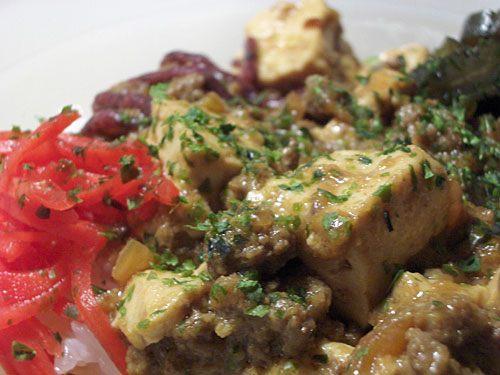This is a guest post from Sarah of Get Cooking, who's back to share another great frugal recipe with us.

Aonori seaweed isn't a common garnish for mabo dofu but some people in my house like it that way.
I know this might be looking a bit too decadent to any lover of authentic Mabo Dofu, but, well, no Japanese dish stays very authentic in my hands for too long. Mabo Dofu, an originally Chinese dish popular in Japan, is meat (beef in this case) and tofu simmered in a red miso-ginger-garlic-chili sauce. Over the years, it has become a staple in my household. Like everything else I make regularly, the recipe changes slightly each time depending on what ingredients and condiments we have around.
The more I make and eat mabo dofu, the more I love it. I used to use sauce packets that you can find in many Asian groceries, but then I realized how much more easy, cheap, and tasty it was to make the sauce myself. While the list of ingredients looks long, it's a very simple dish to prepare. After you have it once, you may even start adding some of the main ingredients to your fridge and pantry staples. Before this dish entered my life, I had an aversion to tofu. Having tofu in a dish where it is not meant as a substitute for something else changed my perspective on the protein completely. This is my favorite use for tofu.
Even though I did not grow up eating Japanese food, this dish tastes like home to me. The suppleness of the tofu, the chewy meatiness of the beef, the silky, salty, tanginess of the sauce that permeates all the other elements, coupled with the firm stickiness of the rice, and the cool crisp of the pickles I tuck in along side make this an adventure for the taste buds.